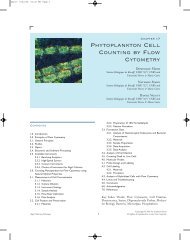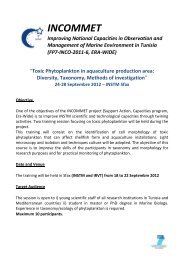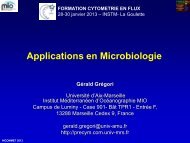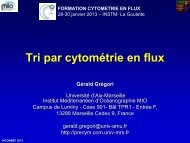Eukaryotic Picoplankton in Surface Oceans - incommet
Eukaryotic Picoplankton in Surface Oceans - incommet
Eukaryotic Picoplankton in Surface Oceans - incommet
You also want an ePaper? Increase the reach of your titles
YUMPU automatically turns print PDFs into web optimized ePapers that Google loves.
Annu. Rev. Microbiol. 2011.65:91-110. Downloaded from www.annualreviews.org<br />
by CSIC - Consejo Superior de Investigaciones Cientificas on 09/27/11. For personal use only.<br />
HPLC: highperformance<br />
liquid<br />
chromatography<br />
Molecular survey:<br />
study of the diversity<br />
of natural assemblages<br />
by obta<strong>in</strong><strong>in</strong>g the<br />
environmental<br />
sequences of a given<br />
marker such as the<br />
rDNA gene<br />
High-throughput<br />
sequenc<strong>in</strong>g: set of<br />
new technologies<br />
produc<strong>in</strong>g thousands<br />
or millions of DNA<br />
sequences at once by<br />
paralleliz<strong>in</strong>g the<br />
sequenc<strong>in</strong>g process<br />
higher cell abundances. Another mechanism of<br />
algal mixotrophy is the osmotrophic <strong>in</strong>corporation<br />
of dissolved organic matter (83). Both<br />
particulate and dissolved organic matter uptake<br />
may supplement the nutritional needs of the<br />
mixotrophic cell.<br />
Regard<strong>in</strong>g HPE cells, some can <strong>in</strong>gest small<br />
phototrophs such as picocyanobacteria or PPE,<br />
thus be<strong>in</strong>g herbivores <strong>in</strong>stead of bacterivores<br />
(75). In addition, it rema<strong>in</strong>s to be explored<br />
whether bacterivorous HPE can perform osmotrophy<br />
to supplement their diet, s<strong>in</strong>ce the<br />
smallest bacterial osmotrophs are assumed to<br />
have a competitive advantage over eukaryotes<br />
<strong>in</strong> diluted systems. Nevertheless, osmotrophs<br />
such as thraustochytrids have been detected<br />
both <strong>in</strong> the coast and <strong>in</strong> the open sea (65). F<strong>in</strong>ally,<br />
the importance and prevalence of parasitism<br />
<strong>in</strong> the sea, especially <strong>in</strong> pelagic habitats,<br />
probably have been underestimated, and some<br />
HPE cells could <strong>in</strong>deed be dispersal stages of<br />
parasites of larger mar<strong>in</strong>e organisms (12, 14,<br />
31, 77).<br />
BEYOND BULK ASSEMBLAGES<br />
Need for Molecular Approaches <strong>in</strong><br />
Diversity Studies<br />
Fundamental knowledge has been ga<strong>in</strong>ed<br />
through the bulk study of the abundance,<br />
biomass, and activity of mar<strong>in</strong>e picoeukaryotes.<br />
However, picoeukaryotes <strong>in</strong>clude different<br />
cells. Epifluorescence microscopy displays<br />
only a few features such as size, general<br />
shape, and the presence of plastids and flagella<br />
(Figure 1), so picoeukaryotes cannot be classified<br />
even <strong>in</strong>to a high-rank<strong>in</strong>g taxonomic group<br />
except <strong>in</strong> a few cases (Figure 1c,d). This is far<br />
from the resolution obta<strong>in</strong>ed by <strong>in</strong>verted microscopy<br />
<strong>in</strong> larger protists such as d<strong>in</strong>oflagellates<br />
or diatoms. Electron microscopy has a<br />
large potential for morphological <strong>in</strong>spection,<br />
but many cells are lost or rema<strong>in</strong> unidentified<br />
when process<strong>in</strong>g natural assemblages (84).<br />
Phytoplankton groups can be assessed by highperformance<br />
liquid chromatography (HPLC)<br />
pigment signatures (42), but only at a broad<br />
taxonomic resolution. Cultur<strong>in</strong>g could also<br />
provide <strong>in</strong>sights <strong>in</strong>to <strong>in</strong> situ diversity. Cultured<br />
PPE belong mostly to Pras<strong>in</strong>ophyceae, Pelagophyceae,<br />
Bolidophyceae and P<strong>in</strong>guiophyceae<br />
(82), and HPE to Bicosoecida and Chrysophyceae<br />
(39). However, culture-based surveys<br />
and molecular surveys often do not agree (54).<br />
Moreover, quantification based on the most<br />
probable number (MPN) method yields low<br />
counts for heterotrophic flagellates (11) and<br />
only realistic counts for some PPE such as Micromonas<br />
(80). The poor MPN results, a method<br />
based on replicate cultures from serially diluted<br />
samples, further stress the cultur<strong>in</strong>g bias <strong>in</strong> microorganisms.<br />
Due to <strong>in</strong>herent limitations of the above<br />
methods, picoeukaryotes were treated for<br />
decades as a black box of difficult access, as occurred<br />
for mar<strong>in</strong>e prokaryotes. Microscopic or<br />
pigment surveys failed to identify most cells,<br />
and only a few could be assigned to a class.<br />
Moreover, it was not clear whether the whole<br />
natural diversity was represented <strong>in</strong> culture collections<br />
or whether isolated stra<strong>in</strong>s were good<br />
models to explore the ecological and evolutionary<br />
significance of mar<strong>in</strong>e picoeukaryotes. New<br />
<strong>in</strong>sights <strong>in</strong>to the microbial world arrived with<br />
molecular tools, which revolutionized microbial<br />
ecology. A multifaceted approach can now<br />
be used to <strong>in</strong>vestigate cell abundance, diversity,<br />
and function of picoeukaryote populations<br />
(Figure 3).<br />
The diversity of mar<strong>in</strong>e picoeukaryotes can<br />
be addressed by sequenc<strong>in</strong>g environmental<br />
genes. A first approach amplifies 18S rDNA<br />
from picoplankton DNA, clones PCR products,<br />
and sequences several clones. Sem<strong>in</strong>al studies<br />
revealed an unexpectedly large and novel<br />
diversity (20, 50, 58), a view confirmed <strong>in</strong><br />
posterior reports target<strong>in</strong>g other genes. Surveys<br />
based on ribosomes (<strong>in</strong>stead of genomic<br />
rDNA) are adequate to detect the active community<br />
(59), whereas other studies focus on<br />
phototrophs by target<strong>in</strong>g plastid 16S rDNA<br />
(45) or photosynthetic genes (53) or focus on<br />
given l<strong>in</strong>eages by us<strong>in</strong>g group-specific primers<br />
(49). High-throughput sequenc<strong>in</strong>g methods,<br />
with the power to yield millions of sequences<br />
96 Massana








